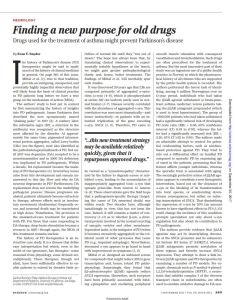Join getAbstract to access the summary!

Join getAbstract to access the summary!
Evan Y. Snyder
Finding a New Purpose for Old Drugs
Drugs used for the treatment of asthma might prevent Parkinson’s disease
Science, 2017
What's inside?
Drugs used to treat asthma find another use in Parkinson’s disease.
Recommendation
Recent scientific advances have allowed researchers to better define the mechanisms of action (MOA) underlying Parkinson’s disease (PD). Such developments in PD research serve to expand the fundamental knowledge of the disease, referred to as the “shaking palsy” back in 1817. The article explores some of the steps necessary to further optimize PD therapy and treatment as well as its relationship to asthma. getAbstract recommends this article to physicians and scientists concerned with the treatment of PD.
Summary
About the Author
Evan Snyder is director of the Center for Stem Cells and Regenerative Medicine at Sanford Burnham Prebys Medical Discovery Institute in California. Snyder obtained his MD and PhD in neuroscience from the University of Pennsylvania.
















Comment on this summary